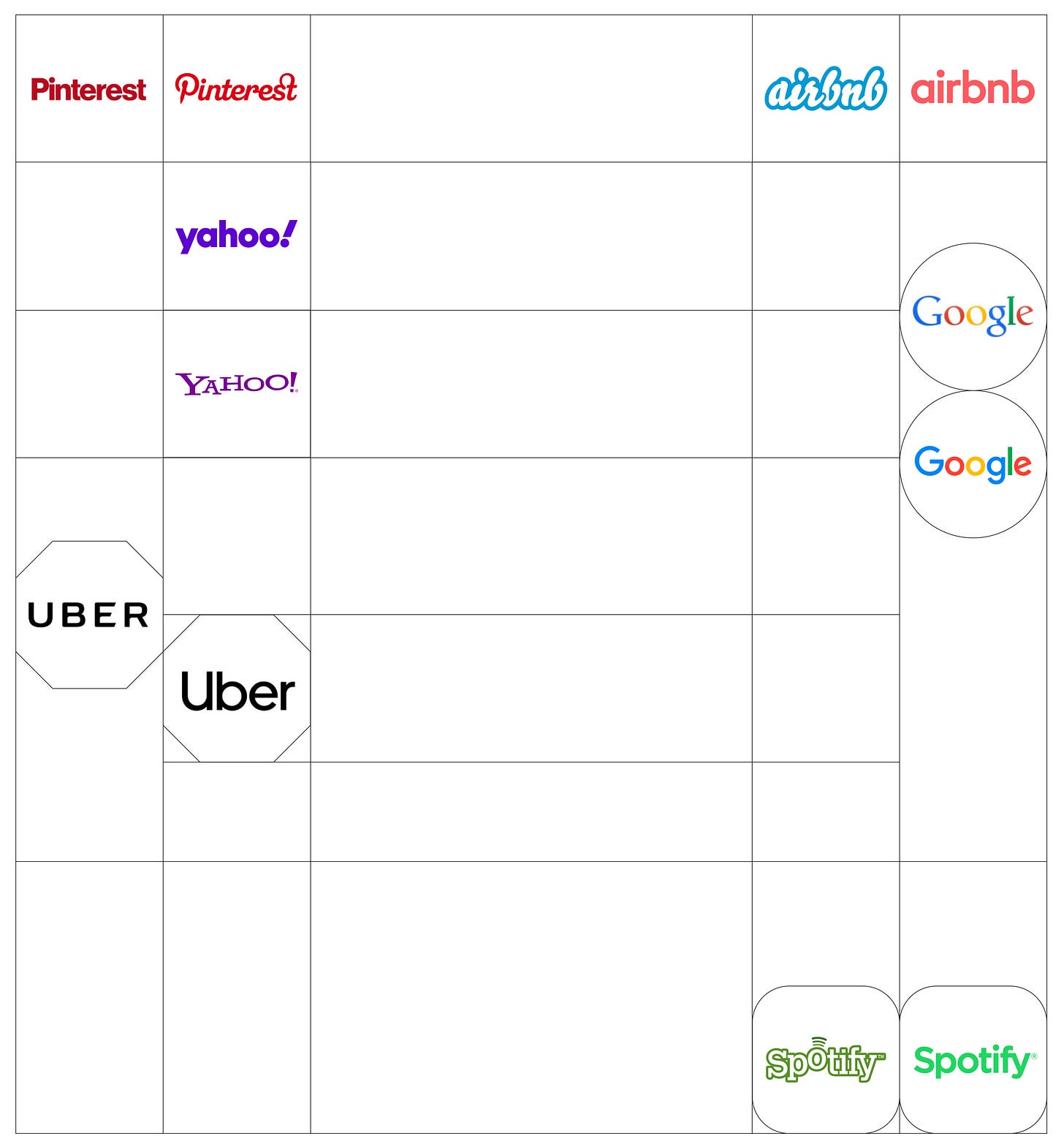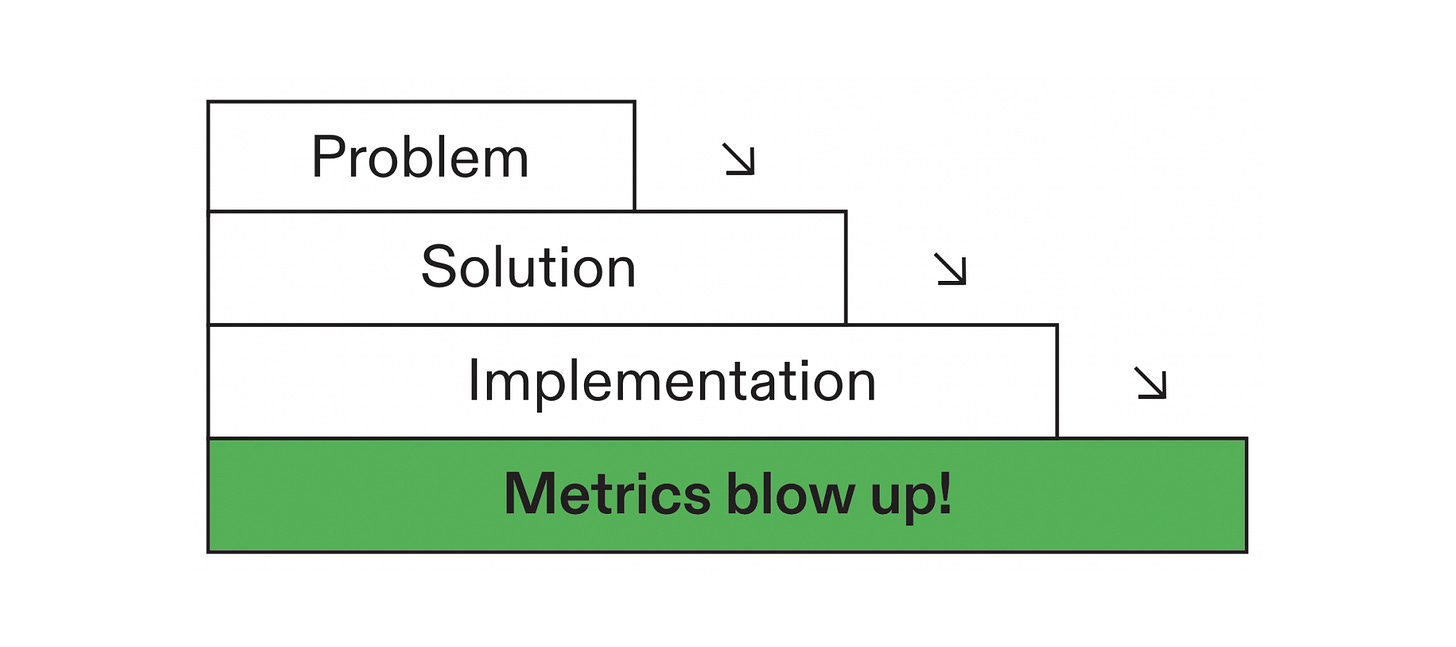In the sea of sameness
On authenticity
Finding a soul in this world seems to be a rare quality these days, especially in software-internet-land.
The rise of Tailwind, design system templates, and other dev frameworks has made it easier than ever to achieve visually appealing designs, often without the need for a designer’s hands. Out-of-the-box components, elegant icons, and ready-to-apply CSS are now within reach for whoever desires.
This abundance has made programming life easier while speeding up the design process, but it also appears to dull creative thinking. Alongside trends that come and go, sameness has become the default state. The spark of the past has faded in many aspects, far beyond the digital sphere: quirky tech brand logos have turned banal, social networks media wear the same interface, and web design is.. well, web design.

Furthermore, the authentic self might vanish soon, as we’re already in a prompt-of-a-button era, allowing us to create nearly identical outputs.
Above the surface, this reality might be only perceived by us, the designers. Design is ever-changing, a cultural byproduct shaped by countless variables.
However, to fully understand how we got here, it’s essential to look beneath the surface. Examining the final design output alone isn’t enough. We have to introspect into our own inner world—our own subculture.
We’re now making design harder with all these “rules” and unnecessary design tool features making it more difficult to understand basic design. We want to sound smart. Look smart. Now it’s just designers designing for other designers.
@DannPetty · Sep 10 2022Design → ← Business
As design became a subset of the product-startup terra-firma, we’ve gone from cultivating taste to worshipping metrics. Data-driven culture, while useful for rationalizing business decisions, has skewed priorities away from craft and toward technocracy.
While metrics are important (although I might hold an unpopular opinion here), they’re not a universal North Star. We should seek to understand analytics, but with caution. Companies invest heavily in collecting data, yet analytics alone can’t fully reveal the secrets of art or guide the creation of something meaningful. There are times when taste and intuition should be prioritized.
In an era where anyone can create anything, cultivating taste is more crucial than ever. When everything starts to look the same, the value of opinionated design becomes undeniable. Like artists, designers should cultivate their own unconventional ways of seeing.
Follow your gut.
Follow your senses.
Follow your taste.
Design → ← Designers
Look at the average designer’s portfolio and you’ll see a common pattern:
This structure, shaped by tech recruiters, educators, and design veterans, has contributed to the diminishing value of the design role. The view of designers has been fixated on a supposedly narrow angle, which is figuring out how to solve problems.
Are we just “solving problems”? Are we just fixing things? I don’t view design as a plumbing profession. What we deal with goes far beyond only black-on-white areas; in fact, it’s mostly grey. Design evolves in countless ways, and reducing it to mere problem-solving is far too shallow.
The portfolios are too structured: “first define problem, then make personas, then you do this, etc”
It would help set students up better if they were set with a challenge more like “this expected design for this feature is needed in 2 weeks with x,y,z constraints”
@tsantsai · 8:30 PM · Aug 26, 2021Moreover, the design process isn’t schematic. It’s a back-and-forth, forward-and-backward effort. It’s not a linear activity where things get built brick by brick in a harmonious way.
Although people and companies have tried for years to market a hyped cure for their own benefit, the truth is that there’s no such thing. Despite all efforts, design systems and other similar frameworks could never fully control or box in creativity.
Hence, I like it when designers take a different approach to showcase their work, and more profoundly, their personality. I find a personal website more effective than a traditional portfolio. It can be as radical as chaos or as super minimalist. It can be as creative as being “powered by a Google Doc” or using humorous copy as a way to be distinguishable.
It’s time for designers to look for ways to re-authenticate themselves. At times it will be noticeable, at others, completely hidden. It might turn out to be a masterpiece—or buried in your drafts.
Design → ← Craft
Nir Tibor AKA Dennis Lloyd is a generalist musician who writes, produces, and performs his own music. Early in his career, he moved far away from his home in Israel to the Thai capital of Bangkok, where he lived for an entire year, solely focusing on making music.
Thousands of miles away from his family and friends, Tibor wasn’t only isolated from people, but also from the world. In a podcast interview discussing those early days, he mentioned that he disconnected his small rented flat from the internet as a way to avoid outside influences.
This act was Lloyd’s way to find authenticity in his craft. For him, going off the grid was necessary so that he could express his true inner self, without being directed by trends and pop culture episodes.
This might sound radical, yet I think there’s something to be learned here.
We designers rarely work in silos; we mostly operate within teams, departments, and other structures. We also tend to be very close to our source—curating references in gazillion browser tabs, notes, and artboards. Personally, I find it extremely hard to design without an internet connection, restricted from the vast reference ocean.
The ways to extract creativity from oneself don’t have to be so extreme; however, cultivating the right environment is essential.
Our authentic self-expression often comes through a unique style and personal taste—elements that set each creative work apart. Without this focus, it’s easy to fall into the trap of imitation.
So, the challenge lies in cultivating taste—developing a discerning eye and a personal language of design. This process allows for a deeper connection to one’s creative instincts while still drawing inspiration in a meaningful and intentional way. With endless sources of inspiration available, the key isn’t to copy but to curate and reinterpret in a way that feels true to us.
Trends will always be here, undeniably, waiting for us to pick them up. Although it’s hard to reinvent the wheel once it’s already been invented, there might be ways for us to delicately reinvent small things.
Sometimes making something banal is just fine, but other times, it’s better to be elevated. This isn’t general advice to reinvent form factors from the ground up, but rather to find ways to make things more authentic, with a true purpose in mind.
“STRANGE, STRANGE OR BE FORGOTTEN
ABSTAIN FROM THE PASSING FASHION
IF FAME IS REALLY AN ILLUSION THEN
BE STRANGE, STRANGE OR BE FORGOTTEN”
Temples
Strange or Be Forgotten
This piece was originally published in niche design, a self-published magazine exploring where design flourishes in an age of sameness.





How to set yourself apart when companies want you to be another pixel pusher that will do the same "bland as flour" design, and will expect that in your portfolio? Every car wants to be a Tesla. Every phone wants to be an iPhone. Every laptop, a Macbook. It's Ford's black cars all over again. Efficiency, efficiency, efficiency.
The Dennis Lloyd example really hit home for me. Sometimes constraints can actually librate creativity rather than limiting it. It's fascinating how removing acces to endless inspiration forces you to dig deeper into your own instincts. The point about design portfolios all looking identicl resonates too. We've optimized so hard for what recruitrs want that we've lost the plot on what makes design interesting in the first place.